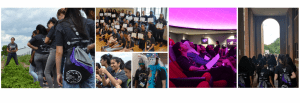Hi everyone! My name is Katie Horisk, and I recently joined the ASOM team! I am a PhD student working with Dr. Sarah Ivory at Penn State. I am currently conducting pollen analysis on the rock hyrax (Procavia capensis) middens, in order to reconstruct past vegetation communities and changes in their composition through the mid-Holocene to present.
I had the opportunity to join the most recent field season in Oman, which was my first trip to the country. It was an incredible experience. In Muscat, Sarah and I paid a visit to the Oman Botanic Garden, where I got to meet some of the plants responsible for the pollen I see under the microscope. We also met with the Ministry of Heritage and Culture in both Muscat and Salalah, where we updated our collaborators on the goals for that trip. After three weeks in the field in Dhofar, we managed to collect 63 more middens! This was a well-earned reward for long days surveying the hot desert wadis. The landscape looks barren from a distance, but there are so many small plants and flowers that thrive on the weathered slopes. There had been a long rainy season, which meant we got to enjoy a more verdant February than usual. Immersing myself in the unique environment of Dhofar helped to contextualize my work enormously.
In addition to toiling under the desert sun, we took long lunch breaks in shady caves. Who knew eating canned hummus could become one of the best parts of the day? Our ministry representative, Aly Al-Mehri, would make tea over an open fire, then use the coals to burn Frankincense! On the weekends we took trips to beautiful beaches, explored the Souq, and got to see archaeological sites excavated by the team as well as the site of Sumhuram (the ancient port city and center of the Frankincense trade). I enjoyed getting to know our Omani colleagues and learning from them in the field. One day we worked with Ali Alkathiry, and I brought him a large Gastropod fossil I had found. He explained how his ancestors would seek out these stones when they had a stomachache, boil them in water, and then drink the water. Sarah and I shared that the fossils were calcium carbonate, a mineral used in medicines like Tums! He got a kick out of that. This small anecdote demonstrates the extensive knowledge the people of Dhofar have about the landscape. I feel grateful to have gotten to learn even a little about the ways in which they interact with their environment, and I hope to carry what I learned about the people and the place throughout my research. Inshallah we will meet again soon!
 Penn State paleoecologist Sarah Ivory and graduate researcher Katie Horisk explain the hyrax midden paleoecologist research for the STEM Thursdays Eberly College of Science Summer Camp. See them here STEM Thursdays with Eberly College of Science, Week 3 – YouTube
Penn State paleoecologist Sarah Ivory and graduate researcher Katie Horisk explain the hyrax midden paleoecologist research for the STEM Thursdays Eberly College of Science Summer Camp. See them here STEM Thursdays with Eberly College of Science, Week 3 – YouTube

 Abstract: In the Dhofar Mountains of Oman stakeholders are concerned about the social and ecological sustainability of pastoralism. In this study we used interviews with pastoralists to examine the prevailing drivers of pastoralism and how they are changing. We find that people are committed to pastoralism for sociocultural reasons but also that this commitment is under pressure because of husbandry costs and changing values. We find that capital investment in feedstuff enables pastoralists to overcome the density- dependent regulation of livestock populations. However, high production costs deter investment in marketing and commercialization, and there is little off take of local livestock. Our study reveals how pastoral values, passed down within households, motivate pastoralists in the face of high husbandry costs, modernization and social change.
Abstract: In the Dhofar Mountains of Oman stakeholders are concerned about the social and ecological sustainability of pastoralism. In this study we used interviews with pastoralists to examine the prevailing drivers of pastoralism and how they are changing. We find that people are committed to pastoralism for sociocultural reasons but also that this commitment is under pressure because of husbandry costs and changing values. We find that capital investment in feedstuff enables pastoralists to overcome the density- dependent regulation of livestock populations. However, high production costs deter investment in marketing and commercialization, and there is little off take of local livestock. Our study reveals how pastoral values, passed down within households, motivate pastoralists in the face of high husbandry costs, modernization and social change.






